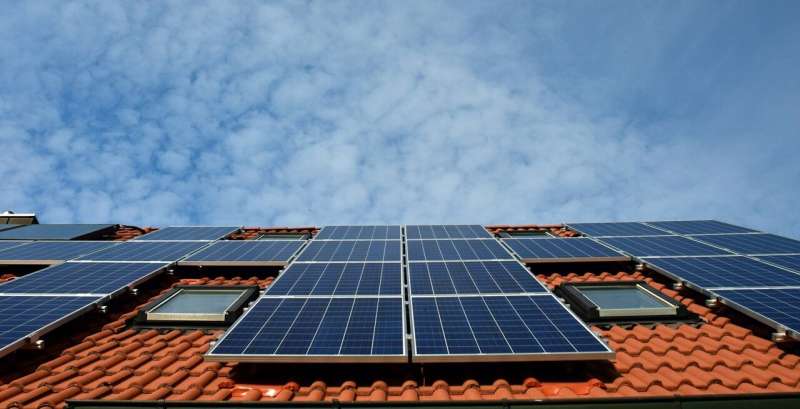
South Africa has many factories, warehouses, schools and hospitals—big buildings with large rooftop spaces. In such a sunny country, these flat surfaces would be perfect for large photovoltaic solar systems that could generate enough renewable energy to supply themselves, and feed into the national grid. This would reduce the amount of coal that South Africa’s national electricity provider would need to burn. Renewable energy engineer and Ph.D. candidate Mamahloko Senatla-Jaane was part of a team who researched how commercial buildings could be set up to serve as strategic assets for decarbonization and increase the security of South Africa’s power supply.
How much space is available and how suitable is it?
We calculated that 111 million square meters (m²) of rooftop space is available on the roofs of universities, schools, hospitals and commercial buildings like shops, warehouses, office blocks and factories.
Our research also found that 80% of these roofs were highly suitable for solar panels. The amount of electricity that commercial building rooftops could hold is 12 gigawatts, or roughly enough to power about six million homes of six people each per year.
There is no public record of the number of commercial buildings and individual size (square meters) of their roofs. So, we used publicly available statistics about floor space to calculate the roof space using a floor-space to roof-space conversion factor.
A square meter built does not translate to a square meter of roof availability. We calculated that for warehouses and shopping centers that are not high-rise buildings, the ratio of floor space to roof space area is roughly the same. For high-rise shopping malls, the roof space is about one third of the floor space.
Similar studies have been done in Beijing, China and in the US using LiDAR (light detection and ranging). This is where lasers were used to detect whether the position of buildings and the amount of shade that fell on their roofs made them suitable for solar installations. These studies showed that up to 85% of rooftops were suitable.
In New Zealand, scientists calculated the annual solar radiation on each square meter of roof area to work out which areas were better suited for solar panels.
How should these rooftops be used?
First, government regulations should be put in place to make installation of solar power mandatory on all the rooftops of all new commercial buildings and large institutions, where the roof design and building location are suitable.
Second, the roofs of existing buildings must be assessed to see if they can participate in a national plan to roll out solar power on their rooftops.
Third, there is a powerful market instrument that can unlock the value of rooftop solar energy. This is where virtual power plants are set up to buy and sell electricity. Prosumers (people or companies who produce and use electricity simultaneously) can sell power to the grid by forming virtual power plant platforms among themselves. The virtual power plant platform aggregates the power produced by these small power plants. It then sells it at one price to either Eskom (the national electricity company or to a municipality, or to other prosumers.
South Africa already has five virtual power plants, but regulations are needed to allow small-scale energy producers to access the market. Currently, there is no national policy that allows small-scale producers to form virtual power plants and sell energy to their municipalities.
Setting up virtual power plants needs a trial project. This determines how much electricity the virtual power plant will bring in and how much it can sell, and can iron out any technical difficulties. Australia is a good example of a country that has worked since 2020 to come up with market rules on how the residential solar systems and batteries should participate in virtual power plants.
What needs to happen next?
At the moment, renewable energy is being installed in an uncoordinated manner by businesses and households. This impedes proper distributed renewable electricity market development in the country.
For example, there is no national plan to ensure that all commercial building rooftops are used to generate solar power. Businesses are not mandated to install rooftop solar photovoltaic systems, even when building from scratch. The current Energy Performance Certificate regulations (which say that buildings must display their use of energy) only need to indicate how much energy is being used to operate a building (the energy efficiency performance). They don’t oblige institutions or companies to say whether they use renewable energy.
This needs to change.
For commercial buildings to participate in the energy market (selling the extra electricity they generate), municipalities and the Department of Energy must establish rules and regulations for participation in the virtual power plants business model.
Once the framework is set and the regulations are clear, the banks must review their funding models for businesses or households that want to participate in this market. They need to offer specific kinds of loans for institutions and businesses to set up solar systems that participate in the virtual power market, and not only for their own energy needs. This is important so that the economic value of virtual power plants can be realized at small scales.
If every suitable future building is to have solar systems installed, building regulations must change. The requirement to have solar photovoltaic systems installed would need to be included in building codes.
This article is republished from The Conversation under a Creative Commons license. Read the original article.![]()
Citation:
South Africa’s big rooftops could power six million homes: How to make it happen (2025, June 23)
retrieved 23 June 2025
from
This document is subject to copyright. Apart from any fair dealing for the purpose of private study or research, no
part may be reproduced without the written permission. The content is provided for information purposes only.













Leave a comment